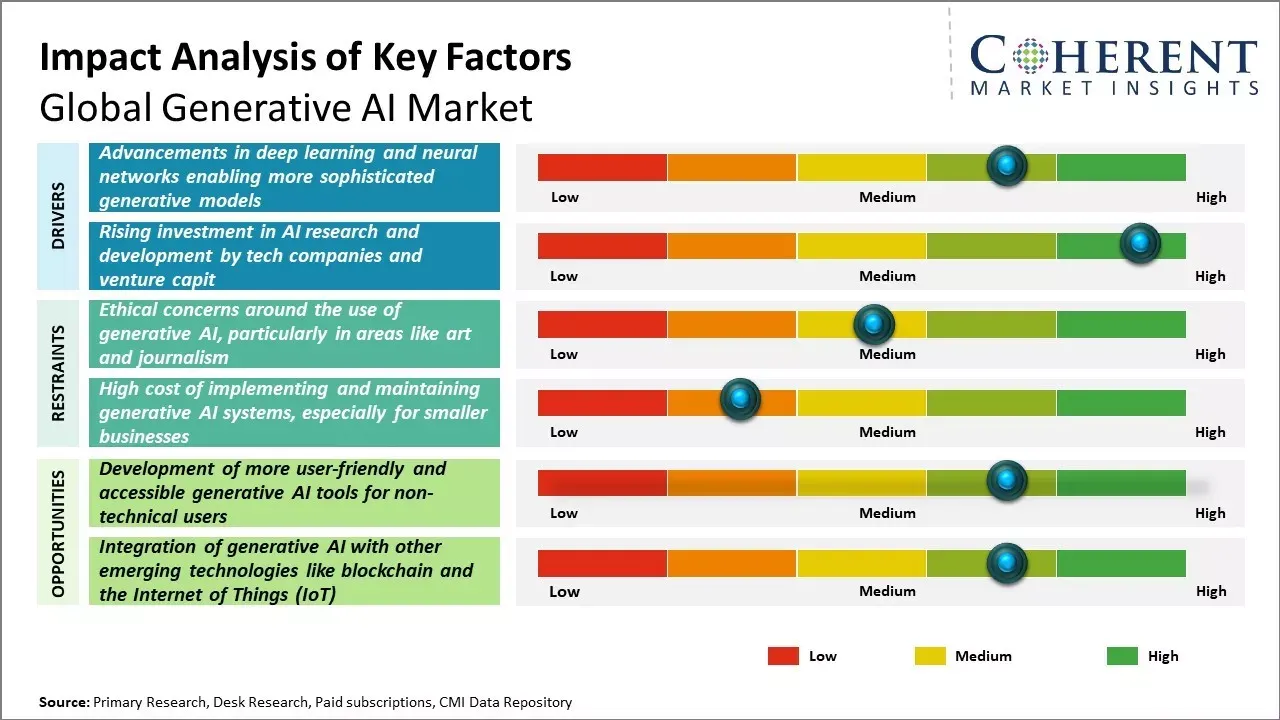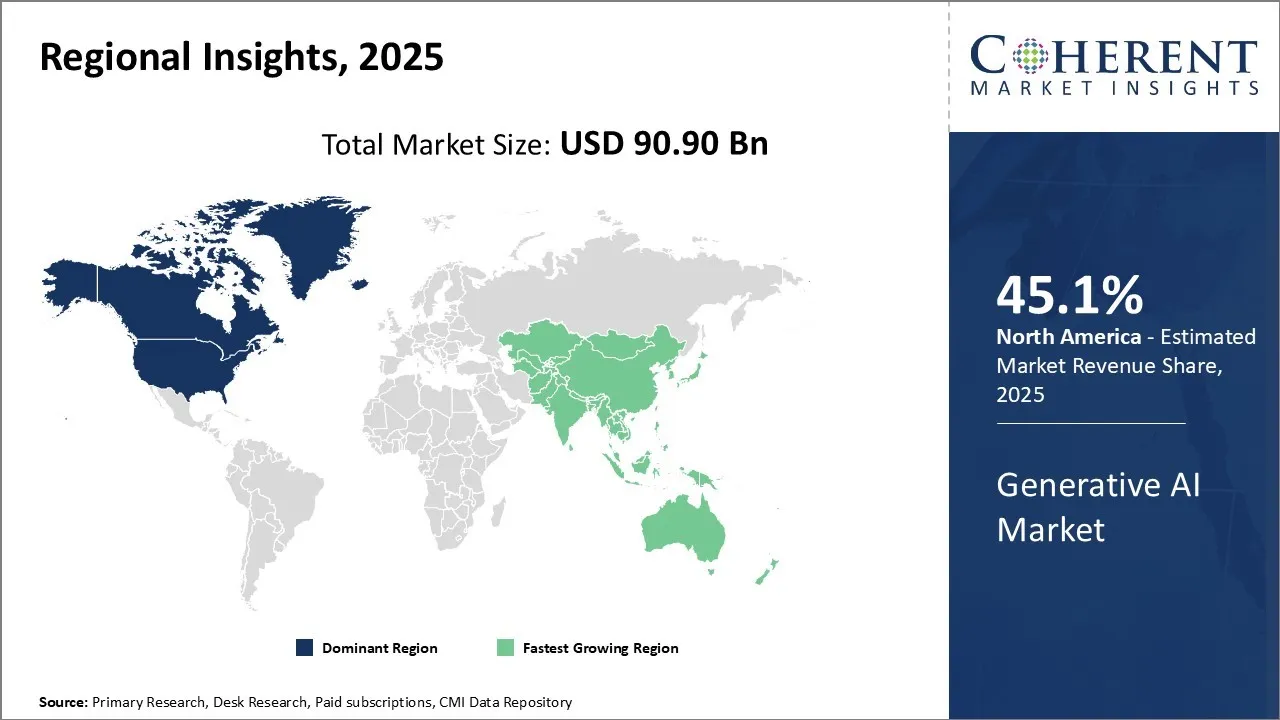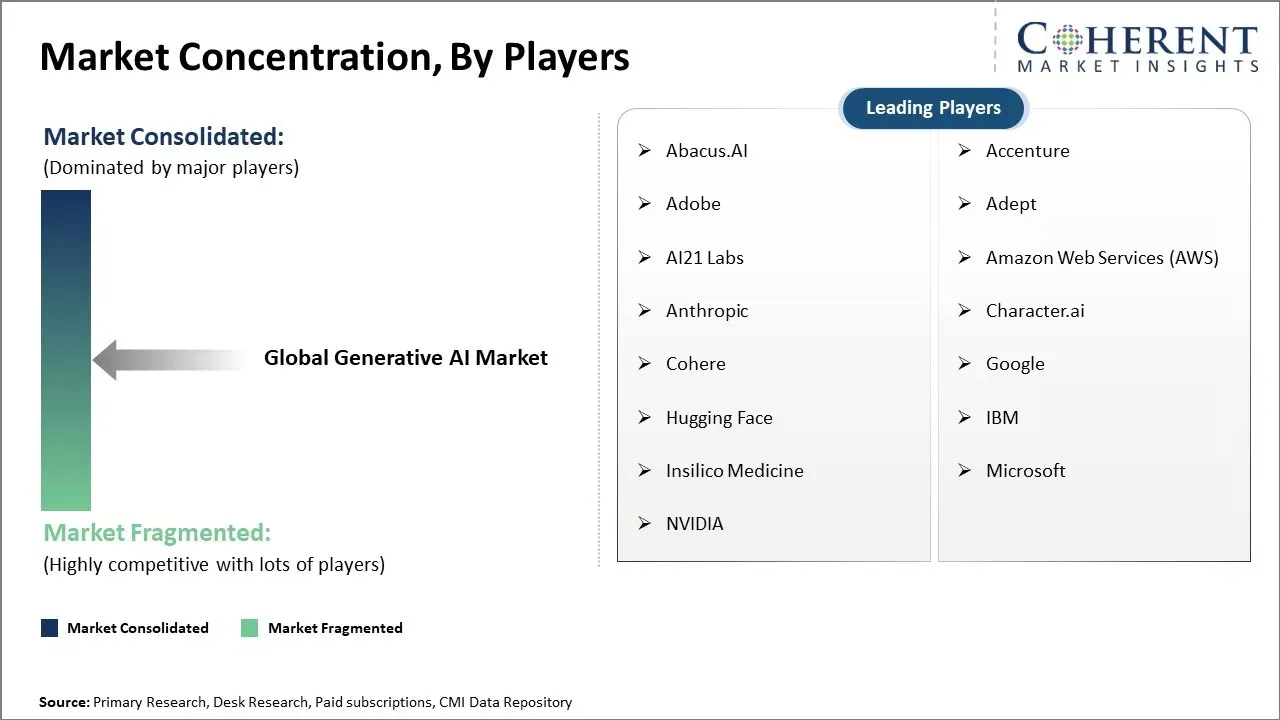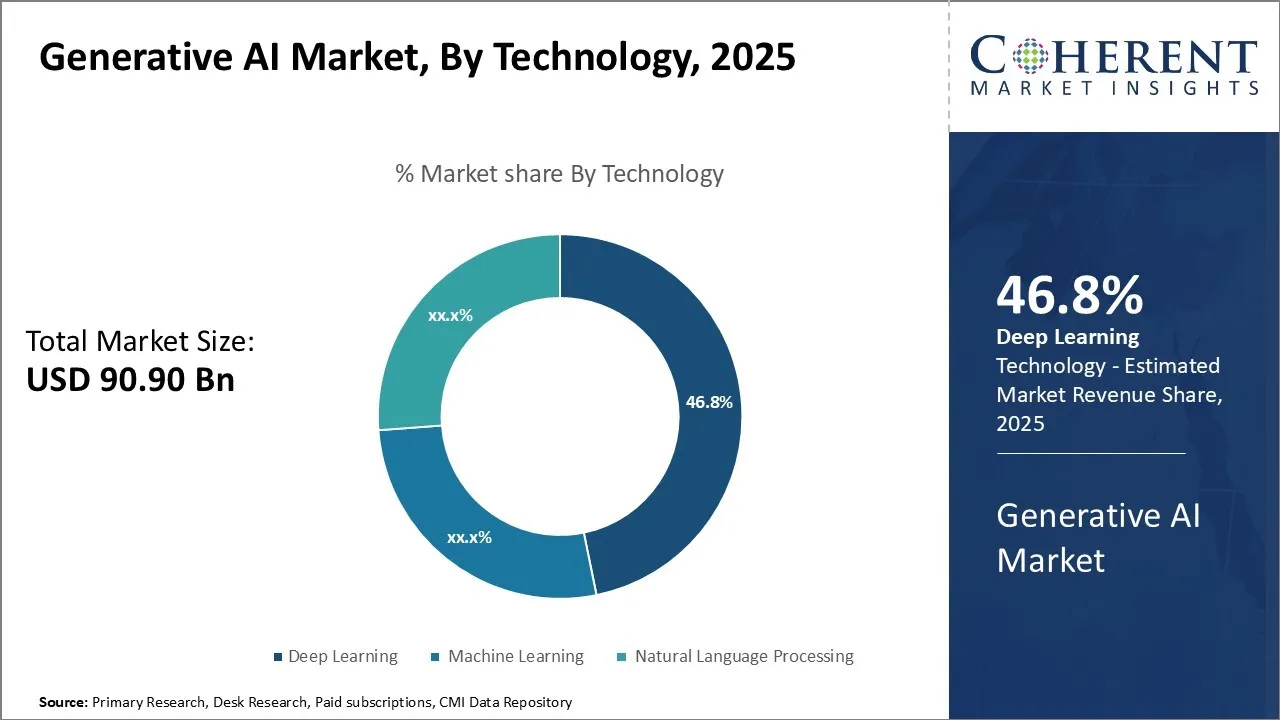Generative AI Market Size and Trends - 2025 to 2032
Global generative AI market is estimated to be valued at USD 90.90 Bn in 2025 and is expected to reach USD 669.50 Bn by 2032, exhibiting a compound annual growth rate (CAGR) of 33.0% from 2025 to 2032.
Key Takeaways
- Based on Technology, the Deep Learning segment is expected to lead the market with 46.8% share in 2025, powering advanced applications.
- Based on Deployment Mode, the Cloud-Based segment is expected to hold 75.9% share of the market in 2025, driven by scalability, affordability, and innovation.
- Based on Application, Content Creation segment is projected to account for 34.7% share of the market in 2025, driven by social media and automation.
- Based on Region, North America is set to lead the generative AI market with 45.1% share in 2025. While, Asia Pacific is anticipated to be the fastest growing region.

To learn more about this report, Download Free Sample
Market Overview
Increasing adoption of advanced technologies powered by artificial intelligence and machine learning algorithms across industries can drive the generative AI market growth. Generative models are gaining popularity as these help reduce costs and increase productivity by automating repetitive manual tasks. The ability of generative AI techniques to learn from large datasets and generate new meaningful information with minimal human intervention can boost demand for generative AI solutions. Advancements in deep learning and ability of generative models to handle large and complex datasets can open new growth avenues for players.
Current Event and its Impacts on Generative AI Market
|
Current Event |
Description and its Impact |
|
EU AI Act Implementation and Global Regulatory Framework |
|
|
Energy Infrastructure Crisis and Sustainability Concerns |
|
Uncover macros and micros vetted on 75+ parameters: Get instant access to report
Industry Adoption
|
Industry |
Adoption Rate |
Key Applications |
Impact/Benefits |
|
Marketing |
37% |
Campaign generation, personalized ads, content |
Boosts engagement, increases ROI by ~20% |
|
Media & Entertainment |
34% |
Scriptwriting, video editing, music creation |
Faster production, creative innovation |
|
Customer Service |
95% (AI interactions) |
Chatbots, automated support, sentiment analysis |
Reduced wait times, 24/7 service availability |
|
Healthcare |
~40% |
Diagnostics, drug discovery, patient records |
Improves accuracy, accelerates research |
|
Finance |
~45% |
Fraud detection, compliance, risk modeling |
Enhances security, reduces compliance costs |
|
Retail & E-Commerce |
40% |
Product recommendations, dynamic pricing |
Conversion rates up 20–30% |
|
Education |
35% |
AI tutors, automated grading, personalized learning |
Reduces admin workload, boosts engagement |
|
Manufacturing |
32% |
Generative design, predictive maintenance |
Cuts prototyping costs by up to 40% |
|
Legal & Compliance |
30% |
Contract drafting, case analysis, compliance |
Reduces prep time by 50% |
|
IT & Software Dev |
60% |
Code generation, bug detection, DevOps |
Shortens cycles by 20–40% |
|
Automotive |
28% |
Vehicle design, autonomous systems, AI copilots |
Accelerates innovation, enhances safety |
|
Real Estate & Architecture |
33% |
AI-generated models, property analytics, virtual tours |
Faster design, improved buyer engagement |
Uncover macros and micros vetted on 75+ parameters: Get instant access to report
Generative AI Market Insights, By Technology - Rapid Adoption of Deep Learning Enables Advanced Data Modeling
In terms of technology, deep learning segment is estimated to contribute the highest market share of 46.8% in 2025, owing to its capability to efficiently handle large and unstructured datasets. Deep learning techniques such as convolutional neural networks, recurrent neural networks and deep reinforcement learning are increasingly being adopted to build generative AI applications that can autonomously learn from data.
For instance, in February 2025, The Deep Learning Institute at NVIDIA made a Generative AI Teaching Kit to help teachers and students learn about deep learning models like GANs, diffusion, and transformers. It highlights GPU-powered ecosystems, industry applications, and practical labs, preparing learners to harness generative AI’s transformative potential across healthcare, finance, media, and manufacturing.
Generative AI Market Insights, By Deployment Mode - Rapid Transition to Cloud-based Platforms Drives Segment Growth
In terms of deployment mode, cloud-based segment is estimated to contribute the highest market share of 75.9% in 2025, owing to on-demand capabilities and low upfront costs associated with cloud-based generative AI solutions. Moving workloads to the cloud allows organizations to focus more on innovation rather than investing heavily in infrastructure. Cloud platforms also facilitate remote collaboration and provide instant access to generative models from any location. This has encouraged companies, especially small and medium enterprises, to adopt cloud-based generative AI services.
Furthermore, pay-as-you-go pricing model of cloud eliminates unpredictable hardware expenses. Maintenance and regular updates of generative models can also be efficiently managed in the cloud. These advantages have accelerated the migration of generative AI workloads to public and private clouds. As advanced cloud capabilities in areas such as auto-scaling and serverless computing emerge, the cloud-based segment can witness growth over the forecast period.
For instance, in February 2025, Fujitsu launched its Cloud Service Generative AI Platform, offering secure, enterprise-ready generative AI via cloud infrastructure. It uses Fujitsu's Takane LLM, GPU-powered systems, and advanced security to keep private information safe. The platform makes it easy to use AI without spending a lot of money. It supports apps like brainstorming, coding, and taking meeting minutes, and it makes sure that everything is compliant and can grow.
Generative AI Market Insights, By Application - Booming Content Creation Industry
In terms of application, content creation segment estimated to contribute the highest market share of 34.7% in 2025, due to massive volume of content being generated daily. Social media engagement and content sharing have expanded significantly in the recent past. This has boosted demand for automated and AI-based content generation techniques. Generative AI models are increasingly deployed by companies to produce personalized and hyper-relevant content at scale. These are able to churn out news articles, product descriptions, social media posts and more with human-level language quality.
Such capabilities are greatly relieving the workload of content writers and marketing teams. Furthermore, entertainment industry also embraces generative AI for tasks like video/image editing, subtitling, localization and digital asset creation. As user-generated and AI-assisted content becomes mainstream, content creation segment will witness growth.
For instance, in June 2025, Nestlé launched an AI-powered content service that uses digital twins and generative AI to make marketing materials and pictures of products. Using NVIDIA Omniverse, OpenUSD, and the Microsoft cloud, it increases the amount of content produced, cuts costs by 70%, and supports personalized campaigns on eCommerce and digital platforms, which boosts customer engagement and brand efficiency.
Regional Insights

To learn more about this report, Download Free Sample
North America Generative AI Market Analysis & Trends
North America has established itself as the dominant region in the global generative AI market with an estimated market share of 45.1% in 2025. The region is home to technology giants and industry leaders like OpenAI, Anthropic, Uber, and DeepMind who have made massive investments in generative AI capabilities like text generation, image generation, and autonomous content creation. Several cutting-edge projects using GANs, diffusion models and other generative techniques are ongoing across universities and national labs in the U.S. and Canada.
For instance, in December 2025, The U.S. Department of War started GenAI.mil, a generative AI platform that works with Google Gemini for Government. It helps with operational planning, compliance, onboarding, and agentic workflows for almost three million people. The initiative aligns with the White House AI Action Plan, modernizing defense operations with frontier generative AI capabilities.
Asia Pacific Generative AI Market Analysis & Trends
Asia Pacific region, especially countries like China, Japan, and South Korea, is emerging as the fastest growing market for generative AI. With a massive population and digital infrastructure, there has been immense scope for utilizing generative technologies at scale. The governments in Asia have proactively drafted policies to encourage domestic AI development, and offer incentives for businesses to integrate generative solutions. Several large conglomerates based in Asia are at the forefront of applying generative AI for novel applications across industries such as manufacturing, healthcare, education and finance.
For instance, in July 2025, Appier started AdCreative.ai in Thailand to help creative marketing change with generative AI. The platform makes ad content automatically, sending personalized images and campaigns to all digital channels. By reducing production costs and accelerating time-to-market, it empowers brands to scale efficiently, enhance engagement, and embrace AI-driven creative innovation.
Generative AI Market Outlook Country-Wise
The U.S. Generative AI Market Trends
The U.S. generative AI market continues to be competitive in 2025 due to many businesses are using it, the government is getting involved, and tech giants like OpenAI, Google, and NVIDIA are leading the way. Healthcare, finance, defense, and media are just a few of the industries that are driving demand for generative AI across the country. They use it to innovate, improve efficiency, personalize services, and gain a competitive edge.
For instance, in December 2025, LodgIQ, based in New York, launched AI Wizard, hospitality’s first generative AI platform for revenue intelligence. Designed for hotels, it leverages advanced AI to optimize pricing, demand forecasting, and operations. This U.S.-driven innovation expands globally, pioneering generative AI adoption in hospitality to enhance efficiency, profitability, and strategic decision-making.
China Generative AI Market Trends
China's generative AI market will be highly favorable in 2025 since the government has invested an incredible amount of funding into it, there are strong open-source projects, and consumers are quickly adopting AI chatbots. E-commerce, manufacturing, and smart cities are some of the industries that are driving growth. At the same time, China's national AI strategies make it a global leader in generative AI innovation and deployment.
For instance, in November 2025, China launched a consumer chatbot powered by its open-source generative AI model, aiming to capture the mass market. Built on large language models, it accelerates adoption among everyday users, expanding AI beyond enterprises. This move strengthens China’s global AI position by democratizing generative AI access for consumers nationwide.
Market Report Scope
Generative AI Market Report Coverage
| Report Coverage | Details | ||
|---|---|---|---|
| Base Year: | 2024 | Market Size in 2025: | USD 90.90 Bn |
| Historical Data for: | 2020 To 2024 | Forecast Period: | 2025 To 2032 |
| Forecast Period 2025 to 2032 CAGR: | 33.0% | 2032 Value Projection: | USD 669.50 Bn |
| Geographies covered: |
|
||
| Segments covered: |
|
||
| Companies covered: |
Abacus.AI, Accenture, Adobe, Adept, AI21 Labs, Amazon Web Services (AWS), Anthropic, Character.ai, Cohere, Google, Hugging Face, IBM, Insilico Medicine, Microsoft, and NVIDIA |
||
| Growth Drivers: |
|
||
| Restraints & Challenges: |
|
||
Uncover macros and micros vetted on 75+ parameters: Get instant access to report
Generative AI Market Driver
Advancements in deep learning and neural networks enabling more sophisticated generative models
With advancements in deep learning techniques like generative adversarial networks (GANs), reinforcement learning, and self-supervised learning, researchers are now able to generate increasingly lifelike images, videos, speech, text and other forms of data. Deep learning models are becoming more powerful as computing capabilities increase and more training data becomes available. Due to unsupervised learning techniques like GANs and autoregressive models, AI systems can now learn the underlying distribution or patterns in datasets without the need for human annotation or labeling. This self-supervised learning enables generative models to produce synthetic data that mimics real data with high fidelity.
Deep neural networks have billions of parameters that can learn rich, high-dimensional distributions over natural data domains like images, audio and text. By learning from huge volumes of unlabeled training examples, generative models can mimic subtle statistical properties like object shapes, textures or sentence structures. Advancements in neural architecture search enable researchers to develop novel network designs that are even better at capturing complex, real-world distributions. The availability of huge computational resources in the cloud allows them to train these models at massive scales for longer periods. Generative models can generate photos, videos and other content that appear highly realistic even to the human eye.
Rising investment in AI research and development by tech companies and venture capitals
Major technology companies like Accenture, Adobe, Adept, AI21 Labs, Amazon Web Services (AWS), etc. and well-funded AI startups are investing heavily in generative AI with the goal of developing new applications and business opportunities. Corporates see huge commercial potential in generative models for personalized experiences, creative works, synthetic training data and others. Venture capitalists have recognized this potential and invest in AI startups each year. This rising investment boosts advancements in generative modeling techniques.
Large firms like OpenAI, Google, AWS, Microsoft, and others have launched initiatives and research labs dedicated to advancing the state-of-the-art in generative modeling, computational creativity and related areas. These are investing in novel model architectures, self-supervised learning methods, massive computational resources and talented researchers. Startups are innovating with new applications of generative AI in domains like art, science, manufacturing and social media. Many tech companies use AI to automate routine design/engineering processes and generate synthetic test/training data to lower costs and boost productivity.
Venture funding for AI startups has increased exponentially in recent years. Unicorns like Anthropic, Stability AI and DeepMind received funding from top VCs. This large influx of capital boosts more innovations that push the boundaries of generative modeling.
Generative AI Market Opportunity
Development of more user-friendly and accessible generative AI tools for non-technical users
The development of more user-friendly and accessible generative AI tools for non-technical users presents a major opportunity for the market growth. Most generative AI systems require advanced coding and machine learning skills, which limits their adoption. However, there is potential to design novel generative AI products and services with intuitive interfaces similar to popular mobile apps and social media platforms. This could make generative text, image, video and audio creation much more seamless and engaging for everyday consumers and businesses. Simplifying the user experience of generative AI tools could help unlock new applications of the technology for industries like marketing, design, education and more. It may also encourage more diverse participation and mitigate concerns about generative content being uncontrolled or misused by non-experts.
Market Concentration and Competitive Landscape

To learn more about this report, Download Free Sample
Analyst Opinion (Expert Opinion)
The generative AI market is going through a quick commercialization phase, with an enormous amount of funding coming in, businesses trying out new things faster, and a small number of foundation-model providers becoming more concentrated. Market-size estimates vary widely due to differing definitions that range from core software to the broader ecosystem of infrastructure, platforms, and applications. Despite this variation, investment and spending indicators consistently point to fast expansion and sustained momentum.
Enterprise adoption metrics show a clear shift from pilots toward operational use. A growing share of organizations reports scaling generative or agent-based AI systems in at least one business function, particularly in customer service, software development, marketing content creation, and knowledge management. However, only a small proportion of enterprises describe themselves as fully mature in AI deployment, highlighting persistent gaps in governance, reliability, and organizational readiness.
The competitive landscape is increasingly polarized. A handful of vendors dominate foundation models and core platforms, while a growing number of specialized players focus on orchestration, safety, and verticalized applications. The model-development layer's high capital intensity keeps making it harder to get in, which pushes commercial value toward application software and workflow integration.
Operational risks remain material. Independent assessments point to challenges around transparency, auditability, and model governance, which are critical for regulated industries. Overall, vendors and adopters who combine generative capabilities with strong data infrastructure, governance frameworks, and clearly defined business use cases are expected to create value in the near future.
Recent Developments
- In December 2025, Nomura Research Institute launched its AI Co-Creation Model with Microsoft Japan and partners to accelerate generative AI adoption. Targeting 100 projects and training 500 specialists, it supports automation, customer service, and business innovation. This initiative strengthens Japan’s competitiveness by embedding generative AI across industries through structured enterprise integration.
- In June 2025, Amazon reached one million robots across global fulfillment centers and introduced DeepFleet, a generative AI foundation model. DeepFleet improves robot travel efficiency by 10%, reducing congestion and boosting delivery speed. With deployments in over 300 facilities, Amazon enhances logistics, lowers costs, and advances AI-driven industrial automation worldwide.
- In January 2025, NTT DATA launched Smart AI Agent™, a generative AI platform to accelerate enterprise adoption worldwide. Featuring task planning, multi-agent collaboration, advanced RAG, and upcoming UITL, it enhances efficiency across industries. Expected to generate $2 billion revenue by 2027, it strengthens global operations in automotive, banking, and manufacturing.
Market Segmentation
- By Technology Insights (Revenue, USD Bn, 2025 - 2032)
- Deep Learning
- Machine Learning
- Natural Language Processing (NLP)
- By Deployment Mode Insights (Revenue, USD Bn, 2025 - 2032)
- Cloud-based
- On-premises
- By Application Insights (Revenue, USD Bn, 2025 - 2032)
- Content Creation
- Chatbots and Virtual Assistants
- Image and Video Generation
- Music Generation
- Others
- Regional Insights (Revenue, USD Bn, 2025 - 2032)
- North America
- U.S.
- Canada
- Latin America
- Brazil
- Argentina
- Mexico
- Rest of Latin America
- Europe
- Germany
- U.K.
- Spain
- France
- Italy
- Russia
- Rest of Europe
- Asia Pacific
- China
- India
- Japan
- Australia
- South Korea
- ASEAN
- Rest of Asia Pacific
- Middle East
- GCC Countries
- Israel
- Rest of Middle East
- Africa
- South Africa
- North Africa
- Central Africa
- Key Players Insights
- Abacus.AI
- Accenture
- Adobe
- Adept
- AI21 Labs
- Amazon Web Services (AWS)
- Anthropic
- Character.ai
- Cohere
- Hugging Face
- IBM
- Insilico Medicine
- Microsoft
- NVIDIA
Sources
Primary Research Interviews
- Generative AI Platform Providers
- Large Language Model (LLM) Developers
- AI Infrastructure & Cloud Service Providers
- Enterprise AI Solution Integrators
- Data Science & Machine Learning Consultants
- Others
Databases
- Bloomberg Terminal
- Thomson Reuters Eikon
- PitchBook
- Others
Magazines
- MIT Technology Review
- Wired
- Forbes Technology
- Harvard Business Review
- Others
Journals
- Artificial Intelligence Journal
- Journal of Machine Learning Research (JMLR)
- IEEE Transactions on Artificial Intelligence
- Nature Machine Intelligence
- Others
Newspapers
- Financial Times
- The Wall Street Journal
- The New York Times
- Reuters
- Bloomberg News
- Others
Associations
- Association for the Advancement of Artificial Intelligence (AAAI)
- IEEE Computer Society
- AI Industry Forum
- Open-Source AI Research Communities
- Others
Public Domain Sources
- U.S. National Institute of Standards and Technology (NIST) – AI Risk Management Framework
- OECD AI Policy Observatory
- European Commission – AI Act & Digital Strategy
- World Economic Forum – AI Governance Reports
- U.S. Census Bureau & Government Open Data Portals
- Others
Proprietary Elements
- CMI Data Analytics Tool
- Proprietary CMI Existing Repository of Information for the Last 8 Years
Share
Share
About Author
Suraj Bhanudas Jagtap is a seasoned Senior Management Consultant with over 7 years of experience. He has served Fortune 500 companies and startups, helping clients with cross broader expansion and market entry access strategies. He has played significant role in offering strategic viewpoints and actionable insights for various client’s projects including demand analysis, and competitive analysis, identifying right channel partner among others.
Missing comfort of reading report in your local language? Find your preferred language :
Transform your Strategy with Exclusive Trending Reports :
Frequently Asked Questions
EXISTING CLIENTELE
Joining thousands of companies around the world committed to making the Excellent Business Solutions.
View All Our Clients

